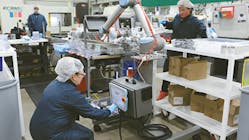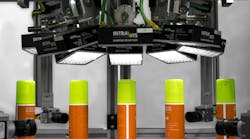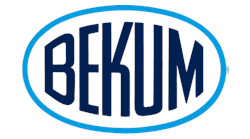The cobots are coming.
Cobots — robots that work collaboratively with workers — are taking root in the plastics processing industry, and early adopters say they perform well at mundane tasks, freeing humans to do more demanding work.
Several trends point to robust growth for cobots.
One is a growing shortage of skilled workers. Another is a shift toward shorter production runs and multiple mold changes. Ease of programming and flexibility coupled with low capital cost allow payback on collaborative robots in an average of six months, according to Barclays Research, London. Barclays sees the global market for cobots growing from $92 million in 2015 to $2.4 billion in 2020.
Donnelly Custom Manufacturing, Alexandria, Minn., is an enthusiastic early user.
"We're a short-run injection molder and we don't have a lot of highly customized automation," said Jerry Bienias, VP operations. "We have tried to be creative in ways to use automation and make it easy to change over for multiple applications. And it's difficult to find labor."
Donnelly installed a Baxter cobot from Rethink Robotics, Boston, in January 2015 and added a second three months later.
A team of five manufacturing staff members, including two floor operators, studied ways to make the best use of the cobots. At first, one was placed at the end of a line to count parts and place them in gaylords. Then one was used to count and place a layer of cardboard before adding more. In the next application, Baxter was used for gate trimming.
"The part counting was important because it was quality control," said President Ron Kirscht. "But now it's also safety and meeting tight specifications in addition to labor savings." Human workers are not replaced at Donnelly; they move on to more demanding jobs. "This ushers in a dawn of a new era where people and machines do what they do best," said Kirscht.
Executives at the Dynamic Group, Ramsey, Minn., said that the payback for their cobots from Universal Robots A/S, Odense, Denmark, was two months.
In one application, the first robot picks and places "book frames" (holders for pieces to be molded) into the injection molding machine, transports the units to a trimming fixture and places the parts in front of an operator for further handling.
The parts are extremely heat sensitive, so cycle times have to be consistent from part to part. "We were having trouble making one good part with manual labor, let alone the various shifts tending the machine cycle differently," said Dynamic Group CEO Joe McGillivray. "We essentially quadrupled our production capacity and our scrap went from significantly high to near zero."
Suppliers said that fast setup is one big advantage of collaborative robots.
"With traditional robots, the capital costs for the robots themselves account for only 25 to 30 percent of the total system costs," said Enrico Krog Iversen, CEO of Universal Robots USA Inc. "The remaining costs are associated with robot programming, setup and dedicated, shielded work cells. The 'out-of-box experience' with a collaborative robot is typically less than an hour. That's the time it takes to unpack the robot, mount it and program the first simple task."
Universal Robots and Rethink Robotics grabbed an early lead in the development and deployment of collaborative robots. Now the major robot producers are jumping into the market, creating a wide variety of choices for users.
ABB Automation, Friedberg, Germany,
which has an installed base of more than 250,000 robots globally, will exhibit its collaborative robot — called YuMi — as part of its robotics exhibit at the K show. YuMi was specifically designed to meet the production needs of the consumer electronics industry, but ABB says it has equal application in any small parts-assembly application, thanks to its dual arms, flexible hands, universal parts feeding system, camera-based part location and precise motion control.
Another K show exhibitor, Kuka Robotics Corp. of Augsburg, Germany, offers two versions of its cobot, the LBR iiwa, or "intelligent industrial work assistant."One has a payload of 15.4 pounds and the other 30.9 pounds.
"The LBR iiwa comes amazingly close to the motion sequences of the human arm," said Ulrike Kroehling, a spokesperson for Kuka. The integrated sensors and the impedance control give the robot a tactile sense, Kroehling said.
Stäubli Corp. made its TX2 generation the centerpiece of its exhibit at June's Automatica trade show in Munich. Equipped with new safety technology, Stäubli said the TX2 "will become the world's fastest safe robot."
Safety is the key feature that makes a collaborative robot different from a conventional fixed-position robot. Systems have been evolving since 2013, when the first industry standards were issued to allow more flexibility in work cell layout. Important guidance was added in February with updates to ISO 10218-1 that specifically address issues related to collaborative robots. The safety supplement is designated ISO/TS 15066:2016.
Each supplier's robot safety strategy is unique. For example, the APAS assistant cobot from Robert Bosch GmbH, Stuttgart, Germany, has a sensor skin to avoid collisions. It is the first robot system to be certified for collaborative operations by the German Social Accident Insurance institute.
Users are urged to conduct a risk assessment based on ISO 12100 Safety of Machinery before deploying a cobot.
According to Barclay's Research, the costs of collaborative robots range from $23,000 for Universal's UR3 to $68,000 for Kuka's LBR iiwa. Some manufacturers are offering promotional deals (even two for the price of one) to get a foothold in the plastics processing industry.
While capital costs are lower for cobots than traditional robots, so is their projected useful life of about 30,000 hours. The useful life of traditional robots is more than fourfold that of cobots.
To date, most suppliers have been competing on cost and safety for smaller jobs. One of the trends in cobots is the development of heavier payloads.
Fanuc entered the market last year with a robot featuring a 77.2-pound payload. At Automatica, Comau SpA of Turin, Italy, introduced the AURA — Advanced Use Robotic Arm — with payloads of 132 pounds and 243 pounds. Laser scanners monitor people in its immediate vicinity. Aura will be available in the U.S. in the second half of next year.
Another trend in product development is specialization.
Proco Machinery Inc., Mississauga, Ontario, has launched a collaborative robotic automation system targeting pick-and-place, assembly and packaging applications in blow molding.
The Robo Packer Basic System includes a six-axis robotic arm, infeed conveyor and a box conveyor all mounted onto a common subframe that in turn is fitted with leveling pads and casters.
So far, manufacturers of injection molding machinery are not developing collaborative robots. "At the moment we don't have any plans in this area," a spokesperson for Engel Austria, Schwertberg, told Plastics Machinery Magazine. Wittmann Battenfeld, Kottingbrunn, Austria, also has no plans to develop cobots.
Even though molding OEMs aren't in the market, a new supplier seems to introduce a cobot almost monthly. More than a dozen companies now make collaborative robots.
Doug Smock
Contact:
ABB Inc., 248-391-8622, www.abb.com/robotics
Donnelly Custom Manufacturing, 651-698-8248, www.donnmfg.com
Dynamic Group, 763-780-8674, www.dynamicgroup.com
Fanuc America Corp., 888-326-8287, www.fanucamerica.com
Kuka Robotics Corp., 866-873-5852, www.kuka-robotics.com
Proco Machinery Inc., 905-602-6066, www.procomachinery.com
Rethink Robotics Inc., 617-500-2487, www.rethinkrobotics.com
Robert Bosch GmbH, 917-421-7209, www.bosch.com
Stäubli Corp., 864-433-1980, www.staubli.us
Universal Robots USA Inc., 631-610-9664, www.universal-robots.com
Yaskawa Motoman, 937-847-6200, www.motoman.com







